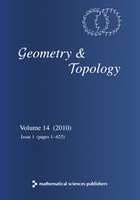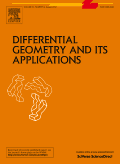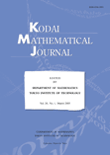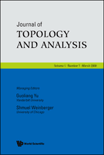
GEOMETRY & TOPOLOGY
Scope & Guideline
Unraveling the Intricacies of Space and Shape
Introduction
Aims and Scopes
- Algebraic Topology:
Exploration of fundamental concepts and theories in algebraic topology, including homotopy theory, cohomology, and spectral sequences. - Geometric Structures and Manifolds:
Study of various geometric structures on manifolds, including symplectic, hyperbolic, and Riemannian geometries. - Low-Dimensional Topology:
Research focused on three-dimensional and four-dimensional manifolds, knot theory, and their invariants. - Homotopy Theory and Categories:
Investigations into homotopy types, higher category theory, and their applications across different mathematical fields. - Representation Theory and Quantum Topology:
Examination of representations of groups and algebras, including quantum invariants and their geometric interpretations. - Moduli Spaces and Geometric Invariant Theory:
Analysis of moduli spaces, their geometric properties, and applications to theoretical physics and algebraic geometry. - Persistent Homology and Topological Data Analysis:
Application of topological methods to data science, including persistent homology and its implications for understanding data shapes.
Trending and Emerging
- Higher Category Theory:
There has been a notable increase in papers focusing on higher category theory, highlighting its relevance in modern mathematical frameworks and its connections to other fields. - Topological Data Analysis:
Research applying topology to data science is on the rise, particularly in the context of persistent homology and its applications in various scientific domains. - Quantum Topology:
Emerging interest in quantum invariants and their geometric implications is evident, with a growing number of studies exploring connections to physics. - Geometric Group Theory:
Research in geometric group theory is expanding, with a focus on understanding groups via their geometric actions and properties. - Symplectic Topology:
The study of symplectic manifolds and their invariants is gaining traction, reflecting a broader interest in the connections between topology and physics. - Noncommutative Geometry:
Research on noncommutative geometry and its applications to topology is becoming more prominent, indicating a shift towards integrating algebraic structures with topological insights.
Declining or Waning
- Classical Knot Theory:
While still relevant, classical knot theory has seen a decline as interest shifts towards more complex invariants and higher-dimensional knots. - Basic Differential Geometry:
Traditional topics in differential geometry, particularly those not intersecting with topology, appear to be less frequently explored in favor of more integrative approaches. - Elementary Group Theory:
Basic results and methods in group theory, especially those lacking topological applications, seem to be receiving less attention in recent publications. - Finite Group Actions:
Research on finite group actions on manifolds has decreased, possibly overshadowed by more intricate studies involving infinite groups and their topological implications. - Homological Algebra without Topological Applications:
There is a noticeable decline in the publication of purely homological algebra papers that do not connect to topological contexts.
Similar Journals

Documenta Mathematica
Advancing Mathematical Knowledge for AllDocumenta Mathematica is a premier academic journal published by the European Mathematical Society (EMS), making significant contributions to the field of mathematics since its inception. With an Open Access model established in 1996, the journal ensures that scholarly works are freely available to a global audience, promoting widespread dissemination of mathematical research. Based in Germany, it serves as a vital platform for mathematicians, covering a wide array of topics within the discipline, evidenced by its impressive Q1 ranking in the miscellaneous category of mathematics as of 2023. Featuring rigorous peer-reviewed articles that span the latest trends and breakthroughs in the discipline, Documenta Mathematica also retains a commendable position among its peers with a Scopus rank of 163 out of 399, placing it in the 59th percentile for general mathematics. Researchers, professionals, and students alike will benefit from the robust scholarly content and the journal's commitment to advancing mathematical knowledge.

TRANSFORMATION GROUPS
Advancing Knowledge through Innovative Mathematical TransformationsTRANSFORMATION GROUPS, published by Springer Birkhäuser, is a leading academic journal specializing in the fields of algebra, geometry, and topology. With its ISSN 1083-4362 and E-ISSN 1531-586X, the journal has established itself as an essential resource for researchers and academicians, achieving a remarkable Impact Factor and ranking in prestigious categories: Q1 in Algebra and Number Theory and Q2 in Geometry and Topology as of 2023. Over its history from 1997 to 2024, TRANSFORMATION GROUPS has delivered cutting-edge research and innovative insights, currently holding Scopus rankings of #40/119 in Algebra and Number Theory and #38/106 in Geometry and Topology. This journal caters to those seeking to enhance their understanding of mathematical transformations and their applications, making it a vital platform for scholarly discourse within the mathematical community.

Cambridge Journal of Mathematics
Elevating Scholarship in the World of NumbersCambridge Journal of Mathematics, published by INT PRESS BOSTON, INC, is a premier platform for the dissemination of cutting-edge research in the field of mathematics. With an ISSN of 2168-0930 and E-ISSN 2168-0949, this journal stands out in a competitive academic landscape, currently ranked #58 out of 399 in General Mathematics, placing it in the top 15% within its category according to Scopus metrics. The journal serves as a vital resource for researchers, professionals, and students alike, aiming to foster groundbreaking mathematical inquiries and foster collaboration across disciplines. Published from 2020 to 2024, the Cambridge Journal of Mathematics is committed to maintaining high standards of scholarship, making it an essential read for those who are passionate about advancing mathematical knowledge and its applications.

Pure and Applied Mathematics Quarterly
Cultivating Dialogue in the Evolving World of MathematicsPure and Applied Mathematics Quarterly is a prestigious journal published by INT PRESS BOSTON, INC, focusing on the diverse and evolving field of mathematics. Since its inception in 2007, this journal has grown significantly, currently holding a Q1 ranking in the Mathematics (Miscellaneous) category for 2023, positioning it among the leading publications in the discipline. With a commitment to publishing high-quality research, Pure and Applied Mathematics Quarterly fosters innovation and dialogue within the mathematical community by providing a platform for theoretical advancements and practical applications. The journal remains accessible to researchers and professionals through its ISSN 1558-8599 and E-ISSN 1558-8602, although it does not currently offer open access. As a vital resource for mathematicians, educators, and students, this journal endeavors to expand the frontiers of mathematical knowledge and contribute to the academic dialogue surrounding this fundamental science.

JOURNAL OF DIFFERENTIAL GEOMETRY
Advancing the frontiers of differential geometry.JOURNAL OF DIFFERENTIAL GEOMETRY, a premier publication by INT PRESS BOSTON, INC, has established itself as a leading forum for the dissemination of high-quality research in the fields of differential geometry, algebra, and analysis. With an impressive history that spans from 1967 to 2024, this journal is recognized for its rigorous peer-reviewed articles, contributing significantly to the advancement of mathematical theories and innovative approaches. Notably, the journal boasts a Q1 ranking in key categories such as Algebra and Number Theory, Geometry and Topology, and Analysis, reflecting its pivotal role within the mathematics community. Its Scopus rankings reinforce its reputation, placing it among the top-tier journals in its respective fields, with a 97th percentile ranking in Algebra and Number Theory, further emphasizing its influence. While the journal does not offer Open Access options, it remains a critical resource for researchers, professionals, and students aiming to stay at the forefront of developments in differential geometry and related domains. Engage with groundbreaking research and explore new methodologies that are shaping the future of mathematics.

DIFFERENTIAL GEOMETRY AND ITS APPLICATIONS
Exploring the Boundaries of Geometry and PhysicsDIFFERENTIAL GEOMETRY AND ITS APPLICATIONS, published by Elsevier, is a premier academic journal primarily focused on the intricacies of differential geometry and its wide-ranging applications in various fields, including mathematics and theoretical physics. Established in 1991 and currently exploring relevant advancements through 2024, this journal serves as a vital platform for disseminating high-quality research that integrates theory and computational methodologies.With an ISSN of 0926-2245 and an E-ISSN of 1872-6984, it holds a significant position within the mathematical community, evidenced by its current quartile ranking of Q3 in major categories such as Analysis, Computational Theory and Mathematics, and Geometry and Topology. While open access options are not available, the journal's contributions are pivotal for researchers seeking to enrich their understanding of complex geometrical frameworks and their practical applications. As the landscape of differential geometry evolves, this journal stands out as a crucial resource for fostering innovation and collaboration among scholars and practitioners alike.

Kodai Mathematical Journal
Bridging Tradition and Novelty in MathematicsKodai Mathematical Journal is a distinguished publication dedicated to advancing the field of mathematics, particularly in miscellaneous areas. Established in 1949, this esteemed journal has been a reputable source for researchers and practitioners who seek to contribute to the rich landscape of mathematical knowledge. Published by KINOKUNIYA CO LTD, the journal is based in the academic environment of Tokyo Institute of Technology and serves a global audience with rigorous and insightful research articles. Despite its current Q3 quartile ranking in the Scopus Mathematics category, which reflects its niche but impactful contributions, the journal is poised for growth; the convergence of traditional and novel mathematical techniques promises to enhance its relevance further. Researchers, professionals, and students are encouraged to engage with the rich content of the journal, aimed at fostering collaboration and nurturing innovation in the mathematical community. While currently not available as Open Access, Kodai Mathematical Journal remains a critical resource for those passionate about mathematics and its applications.

Homology Homotopy and Applications
Innovating the Future of Topological StudiesHomology Homotopy and Applications is a prestigious peer-reviewed journal published by INT PRESS BOSTON, INC, dedicated to advancing the field of mathematics, particularly within the realms of algebraic topology, homological algebra, and their applications. With an impressive Q1 classification in the mathematics category for the year 2023, this journal serves as a crucial platform for researchers, professionals, and students aiming to disseminate their findings in a rapidly evolving discipline. Although open access options are not currently available, the journal retains significant value with its rigorous selection process and high-impact studies. The journal invites submissions that explore theoretical developments as well as practical applications that bridge homology and homotopy theories, thus contributing to the broader scientific community from its base in the United States. With convergence covering years from 2001 to 2024, Homology Homotopy and Applications continues to be a vital resource for fresh insights and groundbreaking research in mathematical sciences.

ANNALES DE L INSTITUT FOURIER
Fostering Innovation in Mathematical SciencesANNALES DE L INSTITUT FOURIER is a premier academic journal published by ANNALES INST FOURIER, specializing in the fields of Algebra and Number Theory as well as Geometry and Topology. Since its establishment, the journal has garnered a distinguished reputation, evidenced by its Q1 quartile ranking in the 2023 category assessments and its Scopus Rank of #37 out of 119 in Algebra and Number Theory, and #34 out of 106 in Geometry and Topology, placing it within the top percentile of its field. The journal serves as a vital platform for disseminating groundbreaking research and innovative methodologies, catering to a global audience of researchers, professionals, and students. With a commitment to the advancement of mathematical sciences, ANNALES DE L INSTITUT FOURIER invites contributions that push the boundaries of knowledge and foster collaboration across disciplines. Although it does not offer open access, the rigorous peer-review process ensures that published papers meet the highest academic standards, making it a critical resource for anyone engaged in advanced mathematical research.

Journal of Topology and Analysis
Exploring the Depths of Mathematical StructuresJournal of Topology and Analysis, published by WORLD SCIENTIFIC PUBL CO PTE LTD, is a distinguished peer-reviewed journal that focuses on advanced topics in mathematics, specifically within the fields of topology and analysis. Established in 2009 and running through 2024, the journal is based in Singapore and strives to present cutting-edge research that contributes to the mathematical community's understanding of geometric structures and analytical theories. Holding a respected position with a Q2 ranking in Analysis and a Q3 ranking in Geometry and Topology according to the 2023 category quartiles, the journal is indexed in Scopus, where it ranks #49 in Geometry and Topology and #118 in Analysis, showcasing its significance in the scholarly landscape. The Journal of Topology and Analysis aims to foster interdisciplinary collaboration by providing a platform for researchers, professionals, and students to share innovative findings and insights. Although it does not currently offer open access, its contributions are vital for advancing knowledge in these mathematical domains.